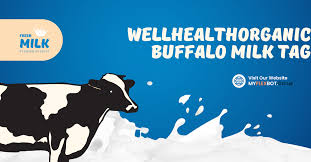Have you ever wondered what wellhealthorganic buffalo milk tag makes buffalo milk so special? If you’ve only been drinking cow’s milk, you might be missing out on some incredible benefits. Buffalo milk, a staple in many parts of the world, offers a unique set of nutrients and properties that make it stand out. So, what makes buffalo milk such a hidden gem, and should you consider adding it to your daily routine?
Understanding Buffalo Milk
Buffalo milk is derived from water wellhealthorganic buffalo milk tag buffaloes, primarily in regions like India, Pakistan, and parts of South Asia. Although less common in Western diets, buffalo milk has been a dietary staple for centuries in many other cultures. It is creamier, richer, and packed with essential nutrients compared to cow’s milk, which is why many are starting to pay attention to its health benefits.
Nutritional Powerhouse
One of the first things you’ll notice about wellhealthorganic buffalo milk tag buffalo milk is its thick, creamy texture. This richness comes from its high-fat content, which might initially raise some eyebrows. However, the fat in buffalo milk is healthier than you may think. It contains more saturated fats and polyunsaturated fats, which are beneficial for brain function, hormone production, and cell regeneration.
Buffalo milk is also a great source of protein. In fact, it has more protein than cow’s milk, making it a fantastic option for anyone looking to increase their protein intake, especially those who follow vegetarian diets. Additionally, it’s loaded with wellhealthorganic buffalo milk tag calcium, phosphorus, and magnesium, which are essential for maintaining strong bones and healthy teeth.
Lactose Tolerance and Digestibility
Buffalo milk might also be easier on the stomach for some people compared to cow’s milk. Although it contains lactose, the composition of buffalo milk makes it slightly more digestible for those with mild lactose intolerance. Some believe wellhealthorganic buffalo milk tag this is due to its higher fat content, which allows for slower digestion, making it easier for your body to process lactose over time.
Immune-Boosting Properties
Buffalo milk is known for its high wellhealthorganic buffalo milk tag content of immunoglobulins and other immune-boosting compounds. These components help the body fend off infections and diseases. For those looking to strengthen their immune system naturally, adding buffalo milk to your diet can be an excellent way to build up your defenses.
Great for Skin and Hair
Because of its richness in vitamins wellhealthorganic buffalo milk tag and minerals, buffalo milk is also fantastic for skin and hair health. The fats, vitamins A and E, and minerals present in the milk nourish and hydrate the skin, giving it a healthy glow. Some even use buffalo milk in natural skincare routines to moisturize and soften the skin. For hair, the protein and fat content can help with strengthening and adding shine, making it a natural beauty booster.
Weight Gain vs. Weight Loss
Some people may wonder if wellhealthorganic buffalo milk tag buffalo milk is suitable for weight loss due to its higher fat content. While it is true that buffalo milk is richer than cow’s milk, it is not necessarily bad for those watching their weight. Because of its creamy nature, it tends to be more filling, meaning you may feel fuller after consuming it. This can reduce your overall caloric intake by curbing excessive snacking or overeating. However, if you are trying to gain weight in a healthy manner, buffalo milk can be an excellent addition to your diet. The healthy fats and high-calorie content make it perfect for those looking to put on weight without resorting to unhealthy junk food.
Buffalo Milk for Babies and Toddlers
If you have a little one at home, you wellhealthorganic buffalo milk tag might be wondering if buffalo milk is safe for babies and toddlers. Experts generally recommend breastfeeding or using formula for infants under the age of one. However, after one year, buffalo milk can be a nutritious part of a child’s diet. It is particularly beneficial for toddlers who need a calcium-rich diet to support growing bones and teeth.
That being said, it is always a good idea to consult your pediatrician before introducing any new food into your child’s diet, especially milk products.
Environmental Impact
Did you know that water buffaloes have a wellhealthorganic buffalo milk tag smaller carbon footprint compared to cows? Buffaloes are generally more efficient in converting feed into milk, which means they require less food and water to produce the same amount of milk as cows. This makes buffalo milk a more environmentally sustainable option, especially as more people are becoming conscious of the impact of their food choices on the planet.
Additionally, buffaloes are less prone wellhealthorganic buffalo milk tag to certain diseases and require fewer antibiotics, making their milk a cleaner, healthier product overall. As sustainability becomes a growing concern, switching to buffalo milk may offer an eco-friendlier alternative to cow’s milk.
Buffalo Milk in Different Cultures
Buffalo milk has long been a part of wellhealthorganic buffalo milk tag various cultural traditions. In South Asia, it is used to make ghee, paneer, and yogurt, all of which are considered staples in Indian cuisine. In Italy, buffalo milk is famously used to produce mozzarella di bufala, one of the most prized cheeses in the world. This rich, creamy cheese is renowned for its soft texture and exceptional flavor, which is why it’s often used in high-end Italian dishes like pizza and caprese salad.
Across these cultures, buffalo milk has wellhealthorganic buffalo milk tag stood the test of time as a nourishing, versatile ingredient. In many households, it’s the go-to milk, not only because of its nutritional benefits but also due to its deeper, richer taste.
How to Incorporate Buffalo Milk into Your Diet
So, how can you start incorporating buffalo milk into your daily routine? The options are endless! If you enjoy coffee or tea, try using buffalo milk wellhealthorganic buffalo milk tag as a creamier alternative to your regular dairy. Its richness will enhance the flavor and provide a more luxurious experience. For cooking, you can use buffalo milk in soups, sauces, or even to make homemade butter.
If you enjoy making smoothies, buffalo milk can add a thick, creamy texture that makes your smoothie more satisfying. Simply blend it with your favorite fruits and a handful of nuts for an energy-packed breakfast or snack.
Buffalo milk also works wonderfully in wellhealthorganic buffalo milk tag desserts. Think of creamy rice puddings, ice creams, or even homemade cheese for a delicious, nutritious treat.
Is Buffalo Milk Right for You?
The benefits of buffalo milk are clear. Whether you’re looking to increase your protein intake, improve your digestion, or make a more sustainable food choice, buffalo milk is an excellent option. However, it is important to remember that everyone’s nutritional needs are different. While buffalo milk is a fantastic source of nutrients for many, some people may need to be cautious due to its higher fat content. If you have specific dietary concerns, it’s always a good idea to consult with a healthcare professional before making any significant changes to your diet.
Final Thoughts: Why You Should Try Buffalo Milk
Buffalo milk is a nutrient-rich, wellhealthorganic buffalo milk tag versatile alternative to traditional cow’s milk. It offers a wide range of health benefits, from boosting your immune system to improving skin and hair health. It’s also more environmentally friendly and offers a richer taste that can elevate your meals.
If you’re curious about trying buffalo milk, don’t hesitate. You may find that this creamy, delicious milk becomes a staple in your kitchen and a key player in your health journey.


